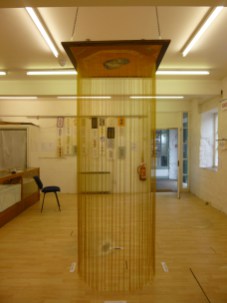My large scale cross-stitch work The Thread of Life (sharing it’s title with the project I ran alongside it), took one year to complete. I had set myself a deadline to ensure that I had an unfinished piece of work. However, I felt like the pressure was on to complete as much as possible of this giant piece of work, measuring one square metre.
The fabric was painted with clay before the sewing began. This was something I was afraid to do in case I ruined the fabric, but when I finally plucked up the courage I was very happy with the result. The idea was that the unstitched areas would leave the clay exposed, mimicking a fresco ceiling.
Although the work was a conceptual piece about time, I felt that I was living this theme in real life, as the stitching took over my life. I worked on it every single day except when I wane on holiday for a week. Sometimes I could only stitch in the evenings, other times I would stitch all day. It became a little depressing to sit in my studio and see the sun pass over as the day slipped by, and yet I had only a small patch of completed sewing to show for it.
Using gold thread was the biggest problem in getting a decent amount of sewing finished each day. Metallic thread is notoriously difficult to stitch with, and you would usually use just one strand at a time. However, for better coverage I decided to stitch with two strands at a time, which resulted in almost every stitch leading to some sort of tangling which needed addressing.
Although I was happy with the results, the amount of energy and time spend on the project left me with some resentment towards the finished work. It is only now that I feel I can look back at the work and be really proud of it. Framed by Graham at Bank Street Framing, the work looks just how I envisaged it, although I still wish I’d had more time to complete more of it. The gold metallic thread really works, and brings a quality to the work with could not have been achieved with a matte gold thread.
The long hanging threads were relatively easy to attach compared to the actual sewing. Each one is held in place on the back of the fabric with a knot and a sequin to stop the knot being pulled back through. The are plaited when the work needs to be stored or transported.
I am very hard on myself and my own worst critic, and through this project I have learnt to be more generous with myself when it comes to the amount of work I commit too. It cost me blood sweat and tears, and I’m left with a permanent dint in my index finger from holding the needle.
I followed up with two smaller pieces of work, which were extracts from the parts of the pattern left un-stitched. I refer to these as fragments, and they were completed just to satisfy my longing to have completed the bottom corner of my pattern.




